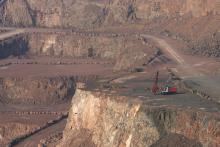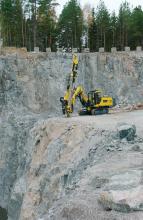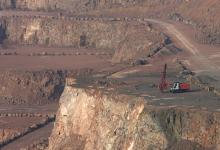
Loading from the face is a key task but which is better - the wheeled loader or excavator?
With the increased focus on cost per tonne and drive for increased efficiency in quarries these days, getting the right loading and hauling equipment in place is essential. But there are a number of different options available to quarry operators when it comes to how the blasted rock is loaded.
Every quarry is slightly different but there are some key considerations when it comes to the choice of equipment for loading at the face. And it is not a case of one size or type fits all and a variety of factors need to be considered.
According to
"If there is a need to 'blend' materials of different grades from various faces, as is often encountered in the cement industry, for example, then the wheeled loader's mobility and subsequent speed with which it can move from face to face, can prove invaluable," explained Sinclair. "An excavator of course would require considerable time to move around site."
Wheeled loaders can also operate loading from multiple faces during one shift thanks to faster travel speeds and can also be used for load and carry duties in other areas of the quarry.
"Use of excavators also offers the ability to dress the top of the face for safety, whereas wheeled loaders do not have sufficient reach to do this on many sites.
"This issue is directly influencing bench heights in the UK and some other countries in Europe - the health and safety authorities believe that the bench should be no higher than the reach of the loading machine so that removing loose blocks can be carried out easily."
Material type
How the material is blasted also has an impact on the choice of loading equipment.
"If the material is more conservatively blasted in order to reduce waste or fines for example, or if explosives are not used at all, then such circumstances will significantly favour the excavator because of its greater ability to penetrate compacted or poorly blasted materials," said Sinclair.
"Regional preferences for either the wheeled loader or the hydraulic excavator as prime movers also exist." The regional difference also create divisions within those opting for excavators with Western Europe preferring back-acting machines and further east quarry operators often use front loading shovels.
Loading patterns
Whichever prime mover is the preferred option, matching it to the hauling fleet and managing the loading pattern is essential to get the most out of the machine.
General consensus across equipment producers seems to be that four to six passes is the optimum loading cycle to keep loading times to a minimum but avoid overloading trucks.
If using wheeled loaders the recommended loading pattern is V loading with the truck reversing in at a 45 degree angle to the face and left to left to ensure eye contact between the truck driver and wheeled loader operator.
With back acting excavators, the machine needs to be on the top of the blast pile and can either V load or drive by load. However, between loading the operator may need to tidy the toes of the pile to ensure the truck wheels are not damaged. The optimum loading pattern for front shovel excavators is the V pattern but as these machines can sit on the quarry floor, they can be more flexible than a back-acting machine.
It is clear that the choice of wheeled loaders or excavators is a key one to the overall operation of the quarry and a decision that needs careful consideration. However, investing in new equipment may not be a viable option in the current economic climate, but making a few adjustments to the loading pattern can significantly improve efficiency.












